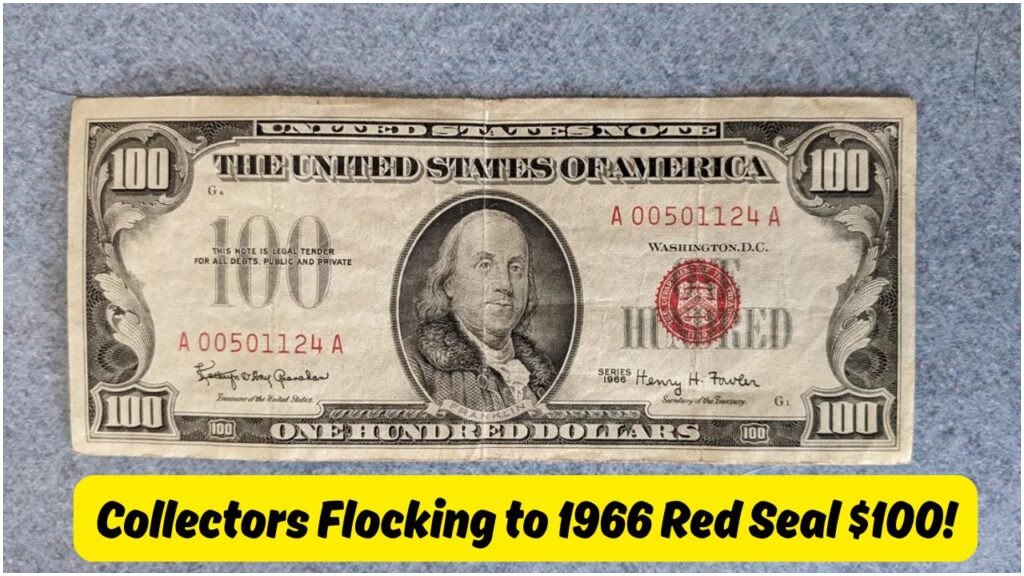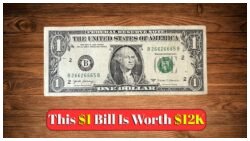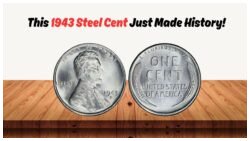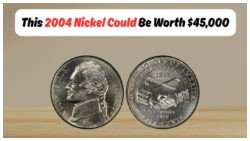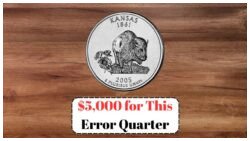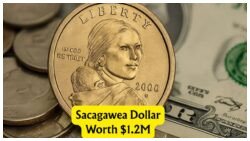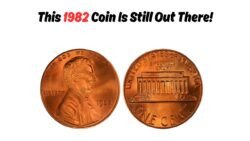1966 Red Seal $100 Note – The world of paper currency collecting, or numismatics, is experiencing a surge in interest around a specific historical piece: the 1966 Red Seal $100 United States Note. Once just another bill in circulation, this note has now become a hot item among collectors due to its rarity, distinctive features, and unique historical context. Let’s explore what makes this vintage note so special and why it’s making waves in the collecting world.
What Is the 1966 Red Seal $100 Note?
The 1966 Red Seal $100 United States Note is a non-Federal Reserve note that was issued directly by the U.S. Treasury. Unlike modern $100 bills backed by the Federal Reserve and featuring green seals, this note carries a bold red seal and serial numbers—making it immediately recognizable.
Key Characteristics:
- Issued in 1966 by the U.S. Treasury, not the Federal Reserve
- Features a red Treasury seal instead of the standard green one
- Serial numbers are also in red ink
- Displays the portrait of Benjamin Franklin
- Contains the text “United States Note” instead of “Federal Reserve Note”
- Carries the signature of Treasurer Kathryn O’Hay Granahan and Secretary Henry H. Fowler
Why Is This Note So Special?
There are several factors contributing to the growing fascination with the 1966 Red Seal $100 note among collectors and investors alike.
1. Limited Issuance
- Only one series year (1966) was issued for the $100 Red Seal notes.
- They were not printed in high volumes compared to Federal Reserve Notes.
- This makes surviving specimens especially rare.
2. Discontinuation of U.S. Notes
- The U.S. government officially discontinued United States Notes in 1971.
- Since then, only Federal Reserve Notes have been issued, making older U.S. Notes historically significant.
3. Unique Aesthetic Appeal
- The striking red seal and serial numbers give the note a visually distinct and collectible look.
- This appeals not only to currency collectors but also to those interested in unique Americana.
4. Rising Market Demand
- Numismatic forums and auction houses have reported increasing interest.
- Clean, uncirculated notes (graded by PMG or PCGS) are fetching $1,000 or more.
Collectors’ Value: How Much Is It Worth?
Value depends on several factors including condition, serial number, and grading. Here’s a breakdown of market trends:
| Condition | Approximate Value | Special Notes |
|---|---|---|
| Circulated (worn) | $150 – $300 | Value above face due to rarity |
| Very Fine | $300 – $600 | Minor folds, still presentable |
| Extremely Fine | $600 – $900 | Slight handling, very crisp |
| Uncirculated (No folds) | $900 – $1,500+ | Highly collectible, investment-worthy |
| Fancy Serial Numbers | $2,000 – $5,000+ | Low, repeating, or star serials |
High-Value Traits to Look For:
- Star notes (replacement notes)
- Serial numbers like 00000012 or 12345678
- Notes with no folds, stains, or ink wear
How to Spot a Real 1966 Red Seal $100 Note
If you’re new to collecting or looking to purchase one of these notes, you must verify authenticity. Here’s what to check:
Physical Features
- The seal and serial numbers should be red and well-printed.
- The paper should feel slightly different from today’s bills—crisper and thicker.
Text Details
- Confirm it says “United States Note” at the top.
- Verify the series date: 1966.
- Look for the specific signature pair: Granahan and Fowler.
Check Against Grading Services
- Buy only from reputable dealers or get the note certified by:
- PMG (Paper Money Guaranty)
- PCGS Currency
Where and How to Buy or Sell This Note
Due to its growing popularity, these notes are increasingly found on online platforms, in currency shows, and at auctions. Here are your best options:
Trusted Buying Sources:
- eBay (check seller ratings)
- Heritage Auctions
- Stack’s Bowers
- Numismatic shows or expos
Selling Advice:
- Get the note graded to enhance value.
- Photograph both sides clearly.
- Highlight any unique serial number features.
- Use high-traffic auction platforms for better visibility.
Should You Invest in the 1966 Red Seal $100 Note?
While all collectibles carry some investment risk, many experts see this note as a smart buy due to its low mintage, historical significance, and rising demand.
Investment Highlights:
- Rare and no longer issued
- Unique appearance draws casual and serious collectors alike
- Steady increase in value over the past 5 years
- Great diversification tool for tangible asset investors
The 1966 Red Seal $100 United States Note isn’t just an old piece of paper—it’s a slice of American history that’s rapidly becoming a prized possession in the numismatic world. With rising collector demand, limited supply, and clear investment potential, now may be the perfect time to consider adding this striking red-sealed bill to your collection.
FAQs
Q1. Is the 1966 Red Seal $100 bill still legal tender?
Yes, it is still legal tender and can be spent, but its collector value far exceeds its face value.
Q2. Why does the note have a red seal instead of green?
Because it was a United States Note issued by the Treasury, not a Federal Reserve Note.
Q3. Can I get these notes at a bank?
No, they are no longer in circulation and can only be bought through collectors or dealers.
Q4. Are ungraded Red Seal notes still valuable?
Yes, but grading increases buyer trust and usually boosts the price significantly.
Q5. How do I preserve a Red Seal note?
Store it in a currency holder or acid-free sleeve, away from sunlight and moisture to avoid deterioration.
What features make the 1966 Red Seal $100 United States Note collectible?
Rarity, historical significance, and demand contribute to its collector attention.

